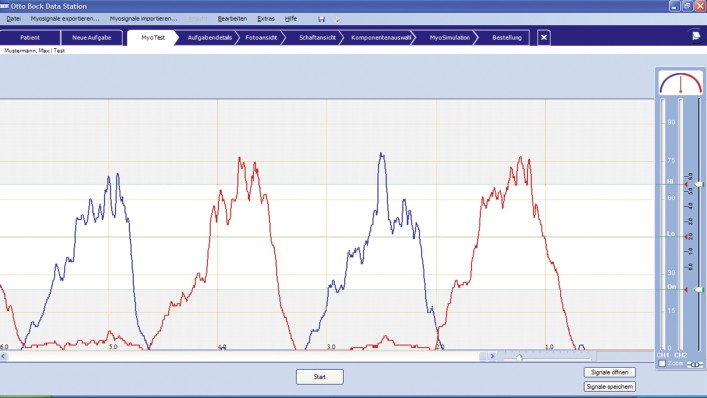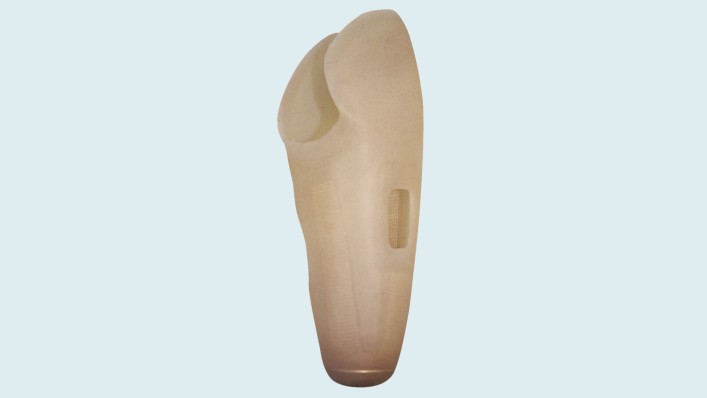Myoelectric prosthetics 101
Find out all you need to know about myoelectric-controlled prosthetic solutions from the world leader in upper limb prosthetics!
About myoelectric
Myoelectric prostheses
For upper-limb amputees, myoelectric-controlled prostheses offer the ultimate combination of function and natural appearance. Designed to mimic human anatomy and motion, electronic components are the closest alternative to an anatomical hand or arm.
Thanks to constantly advancing technology, the latest prosthetic systems feature astonishing capabilities:
Elbows that flex and extend with muscle signals so you can reach for a beverage and bring it to your lips
Wrists that bend and rotate, allowing you to position objects for convenient viewing and handling
Hands that can lug a suitcase or hold an egg without cracking it
Thumbs that can change orientation to over multiple hand positions
What is a Myoelectric prosthesis?
“Myoelectric” is the term for electric properties of muscles. A myoelectric-controlled prosthesis is an externally powered artificial limb that you control with the electrical signals generated naturally by your own muscles.
Hand, wrist and elbow myoelectric components are available. With amputations above the elbow, a “hybrid prosthesis” may combine myoelectric-controlled components with body-powered components to control shoulder and/or elbow function. A skin-like glove covers the prosthesis for a natural appearance.
How does it work?
A myoelectric prosthesis uses the existing muscles in your residual limb to control its functions. One or more sensors fabricated into the prosthetic socket receive electrical signals when you intentionally engage specific muscles in your residual limb. Sensors relay information to a controller, which translates the data into commands for the electric motors and moves your joints. If muscle signals cannot be used to control the prosthesis, you may be able to use switches with a rocker or pull-push or touch pad.

The strength and speed of movements can be controlled by varying your muscle intensity. All of it happens in an instant. For those with damage to nerves or muscles in the residual limb or for people with no arms, muscles in the chest or back can be used to direct movements of a myoelectric prosthesis.
When a myoelectric prosthesis has several joints, each joint might need to be controlled by the same muscle. Sequential control allows positioning of one joint at a time. For example, you might use a muscle contraction to signal the elbow to bend, then use another contraction to signal the hand to close. With AxonBus technology, however, it will soon be possible to control multiple joints simultaneously.

The power behind a myoelectric system
Although a myoelectric prosthesis is controlled by natural electricity generated by your own muscles, the system needs a battery to power motors and electronics, and batteries need charging. Some batteries need to be removed from the prosthesis for charging. With others, a cord from a charging unit can be plugged into the prosthesis.
A myoelectric prosthesis is connected to the residual limb via a custom fabricated socket. The user ‘pulls in’ to the unique socket with a donning sock, which creates suction and helps suspend the socket.
Hybrid prostheses, which combine both myoelectric-controlled and body-powered components, is another option. A hybrid prosthesis may include a hand and wrist controlled that are myoelectrically along with an elbow that is controlled by a harness and cables worn on the torso and controlled by shoulder movements.
Compared to a traditional body-powered prosthesis, a myoelectric-controlled arm provides greater comfort, more range of motion, a larger functional area, and a more natural appearance. It may, however, cost and weigh more.
Prosthetic hands and terminal devices
Because upper-limb prostheses can end with a variety of artificial replacements for a hand, prosthetists refer to this broad assortment as “terminal devices”. With myoelectric prostheses, the options generally fall under these two categories:

Prosthetic hands
The human hand is one of our most complex body parts. A perfect interplay of nerves, tendons, muscles and bones makes it a remarkably versatile, precision instrument. Recreating as many of its numerous functions as possible is one of the greatest challenges for medical technology.
Myoelectric hands may feature:
- A variety of sizes for children as young as 18 months and adults
- A cosmetic glove in a variety of skin colors or a transparent glove to show the hi-tech inner workings
- A hand for amputation at or below the wrist
- Ability to carry heavy loads (up to a set limit)
- Aluminum construction for lighter weight
- A manually adjustable thumb
- A positionable thumb, driven by a separate motor, which allows for multiple grip patterns
- A neutral position for a natural look and action while walking or at rest
- Powerful grip force and grip speed
- Grip force and grip speed proportional to the strength of the myoelectric signal
- A “virtual switch” that requires a slightly stronger myoelectric signal to open the hand after applying maximum gripping force
- A sensor in the thumb that detects friction caused by objects slipping and automatically tightens the grip to prevent dropping
- A slip-clutch to quickly release the hand’s grip in an emergency
- Passive functions to resist weight bearing and other loads
- Multiple grip options, such as pinching with the thumb and index finger, power grip for handles, open palm for holding a platter, opposition power grip for grasping cylindrical object with a big diameter, three-point grip with thumb, index finger and middle finger, and holding flat objects between two fingers
- A handshake function that automatically sets the grip force
- A choice of multiple programs to tailor the speed and build-up of grip force to individual abilities and requirements
- Separate fingers
- Individually powered fingers with movable joints
- Ability to extend the index finger to point or press a button
- Fingers that spread when the hand opens and come together when the hand closes—so you can hold credit cards or bills between your fingers
Terminal devices: Greifer
A Greifer is a powerful, highly functional terminal device made by Ottobock. Designed to perform gripping applications, it excels at manual labor and other tasks. Features may include:
Control of grip speed and grip force
- A flexible joint for convenient positioning
- Adjustable gripping surfaces
- Easy to swap out with other myo hands
- Powerful grip force
Myoelectric wrists
Myoelectric-controlled wrists make it easier to grip and control objects close to the body. They also limit compensating movements you may make with your shoulder and the rest of your body—allowing you to move more naturally.
Capabilities may include:
- Multiple positions of flexion and extension in set increments
- Quick detachment for changing between terminal devices
- A flexible mode that mimics natural movement with a spring-loaded mechanism that returns the wrist to a neutral position
- Progressive resistance in flexible mode
- A rigid mode that locks the flexion or extension in increments for holding and carrying objects
- 360-degree rotation, with stops at multiple positions
Prosthetic Elbows
Myoelectric-controlled elbows, which typically include a forearm, flex and extend so you can do more without unnatural compensating movements. Capabilities may include:
- Bending the elbow in set increments
- Continuous adjustment—variable bending of the elbow—for more natural movement and exact positioning of the prosthetic hand
- Locking and unlocking for reliable loading up to a certain weight limit
- Automatic balance that creates a natural arm swing during walking
- Patient-adjustable counterbalance that makes the arm feel lighter
Is myo right for you?

Is a Myoelectric prosthesis right for you?
A myoelectric-controlled prosthesis may be a good choice if you:
- Had an amputation above the fingers
- Have the ability to control the prosthesis using your own muscle nerves in or near your residual limb
- Want the best combination of function and natural appearance
- Want a solution that will give your greater function for everyday tasks
- Currently have a body-powered prosthesis and:
- Want more grip force or
- Want greater range of motion and a larger ‘functional envelope’ (area of use) or
- Find your harness uncomfortable or restrictive or
- Experience symptoms of overuse or nerve entrapment syndrome in your intact arm or
- Want a more natural-looking prosthesis or
- Want relief from back pain related to unbalanced posture
How to get one: consult a certified practitioner
Conversations with your prosthetist will guide the decision on a prosthetic system. Make sure the prosthetist clearly understands your goals and challenges. Learning about myoelectric prostheses will help you discuss the options and advocate for your preference.
If you are interested in Ottobock’s MyoBock myoelectric prosthetic system, talk to your prosthetist or contact a certified MyoBock practitioner in your area.
Certified practitioners have completed training with Ottobock. Make sure you ask about the prosthetist’s experience with myoelectric prostheses.
Based on your goals, muscle strength, occupation and activities, your prosthetist will prescribe the solution that best fits your needs. The Amputee Coalition offers more detail about this kind of conversation, and Ottobock offers additional background in Prosthetics 101.
An experienced prosthetist understands that your diagnosis and your clinical needs must be documented to justify the components in the prescribed prosthesis as medically necessary, whether for safety or to achieve your potential for a higher activity level.
How to pay for it—are you covered?
Contact your health plan for prior authorization of your prescribed prosthesis. You can also visit our reimbursement pages.
Downloads

- download 2.05 MB | PDF
12K100 DynamicArm Instructions for Use
12K100 DynamicArm Instructions for Use
FAQs
Take a look at our Frequently Asked Questions for more information.
-
How do I get a myoelectric prosthetic system?
Talk to your prosthetist about myoelectric systems and if there’s an appropriate solution for you. He or she will also be able to advise you on the fitting of this advanced technology—and explain how it might be paid for by insurers.
-
How do I pay for a myoelectric prosthetic system?
Begin by contacting your health plan to check on coverage. You can also visit our reimbursement pages for more information.
-
How long will it take before I master my myoelectric prosthesis completely?
How long you require in order to tap the full potential of your prosthesis depends on many factors, including the reason for the amputation, amputation level, condition of the residual limb, and your overall ability.
Your motivation is also an important factor: If you begin preparing yourself for the prosthetic fitting shortly after the operation and train frequently and intensively with the prosthesis later on, you’ll contribute to reducing the time required to reach your personal goals.
-
Can I drive again using the prosthesis?
This also depends on various factors. Please talk to your therapy team and contact the department of motor vehicles in your state.
-
Can I go back to work with my prosthesis?
Depending on your occupation, you can go back to work with your prosthesis. If you perform a job that is physically demanding, you should inform your prosthetist before your prosthesis is made, in order to best determine which components might be right for you.
If your work involves extreme physical strain, you should let your prosthetist know before the pros¬thesis is fabricated, because the type of stress applied to the prosthesis affects the manufacturing of the socket, and the selection of components. Various terminal devices, such as the Ottobock System Greifer or Michelangelo Hand are recommended for specific tasks.
-
Can I ride a bicycle?
Your ability to ride your bicycle depends on the amputation level and the type of prosthesis you have. The Axon-Bus prosthetic system was developed for everyday use and must not be used for unusual activities, for example, sports with excessive strain and/or shocks to the wrist unit (pushups, downhill, mountain biking) or extreme sports (free climbing, paragliding, etc.). Always refer to the the Instructions for Use manual before wearing your Michelangelo hand.
-
Can I go swimming with a myoelectric prosthesis?
No. A myoelectric prosthetic system is not suitable for swimming or taking a shower. Talk to your prosthetist about a specialized swimming prosthesis.
-
How long will my prosthesis last? Will I require any new ‘parts’? When will I require a new prosthesis?
In general, if the socket of your prosthesis fits well and you’re not having any difficulties, then you don't require a new prosthesis. You will likely, however, need new liners or limb socks on a regular basis. Talk to your prosthetist about which liners will work best for you and your prosthesis.
Not finding what you are looking for? Please contact us!
Resources
We’ve collected a variety of helpful links if you’d like further information.
If you or your loved one has recently become—or is about to become—an amputee, please visit our “Info for new amputees” pages on this website. We offer a wealth of information on everything from what to expect during the surgery to working with therapists afterwards.
Amputee Support Program (includes glossary on insurance options – USA)
Kaiser Family Foundation’s Consumer Guide to Making Health Care Appeals
Relevant upper limb systems
- Below elbow prosthesis featuring Michelangelo hand
- Above Elbow Prosthesis featuring DynamicArm
- Greifer terminal device

